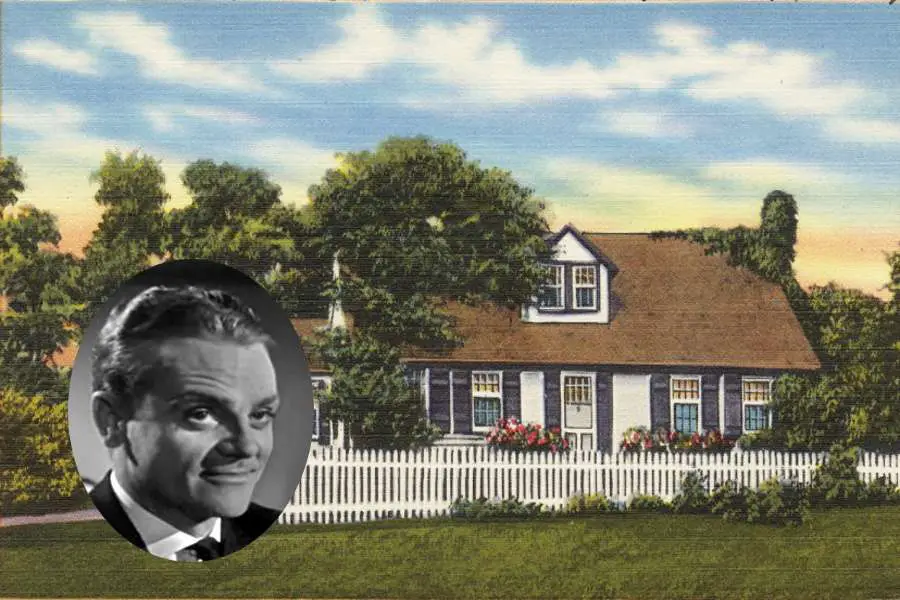Hollywood icon James Cagney took a break from the demands of movie-making in 1936 and bought an antique house and 200 acres on Martha’s Vineyard. Fed up with the movies and movie stardom, he decided he wanted to try his hand at farming.
The Vineyard had yet to attract celebrities like the Clintons, the Obamas, Carly Simon, John Belushi or Jacqueline Bouvier Onassis. Quiet and remote, Cagney sought peace and freedom away from the clamor of Hollywood.

James Cagney around 1930
Cagneys, he wrote, have a deeply ingrained sense of privacy. “We would never intrude upon each other. Each family member would do what he or she had to do without bothering the other.”
You could take that to a ridiculous length. For example, you could build a separate house for your two small children to live in. Which is what James Cagney actually did.
James Cagney
James Cagney’s early life explains, in part, how he ended up on Martha’s Vineyard for nearly 20 years. He was born July 17, 1899 on New York’s Lower East Side to poor parents. His father was an Irish bartender, his mother a half-Irish homemaker. His childhood, he wrote, was marked by trouble, illness and his father’s alcoholism.
“I was very much a city boy,” he wrote in his autobiography. “But one day my dad rented an open four-wheeler known as a barouche and piled me, my mother, and three brothers into it for a two-week visit to my great-aunt in the then open country that is now Flatbush. That vivid memory is with me yet, and I can still see the tremendous elm in her front yard and the morning glories growing on the white picket fence. Ever since those two glorious weeks at the turn of the century, morning glories have been my favorite flower and, just as lasting in its effect, during those few days I changed from a city boy to a country boy.”
Years later, when Rollins College in Florida awarded him an honorary degree, he acknowledged the honor by sending the college an essay he wrote on soil conservation.
Show Biz
He had no intention of going into acting, but someone suggested he try out for a vaudeville drag show called Every Sailor. He got the part. His mother didn’t approve, though, so when the show ended he went to work in a brokerage house as a runner. But then he tried out for a Broadway musical called Pitter Patter, and got a part as a specialty dancer.
He also got a wife. 16-year-old Frances Willard “Billie” Vernon, a chorus girl in the show. They married two years later and stayed married until he died 64 years later.
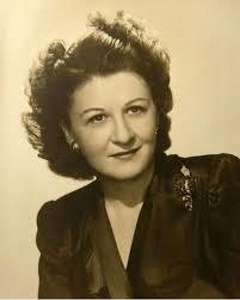
Billie Vernon Cagney
He called marrying Billie “absolutely the smartest thing I ever did.”
“I am still crazy about this lady,” he wrote in his 1976 autobiography.
She was devoted to him. Perhaps too devoted.
Vaudeville and Stardom
He played the vaudeville circuit for the next decade. “Life seemed just a never-ending sequence of damned dingy, badly furnished rooms with a one-burner plate,” he wrote.
He finally got his break in 1930 in a play called Penny Arcade. Warner Brothers decided to make it into a movie starring James Cagney. He went to Hollywood with a three-week contract to play in the film renamed Sinners’ Holiday. He stayed with the studio for 31 years.
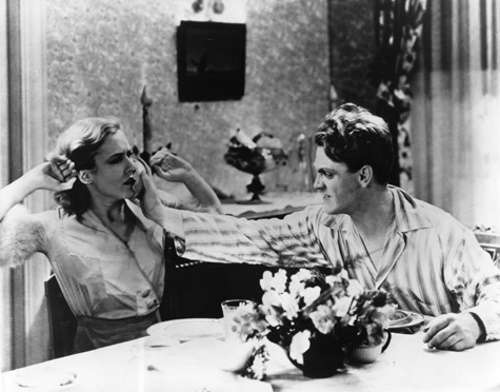
The grapefruit scene in The Public Enemy
By 1936, he had achieved A-list celebrityhood. He had starred in such films as The Public Enemy and Taxi!. In a classic scene in Public Enemy, he shoved a grapefruit in Mae Clarke’s face. It made such a stir he couldn’t go to a restaurant without someone sending a grapefruit to his table, he complained.
He walked out on Warner Brothers in 1932 and in 1935, demanding a fair salary. In 1936, he bought his farm on Chilmark, which then had a population of fewer than 250 people. On Martha’s Vineyard he could order a lobster at Homeport in Menemsha without getting a grapefruit along with it.
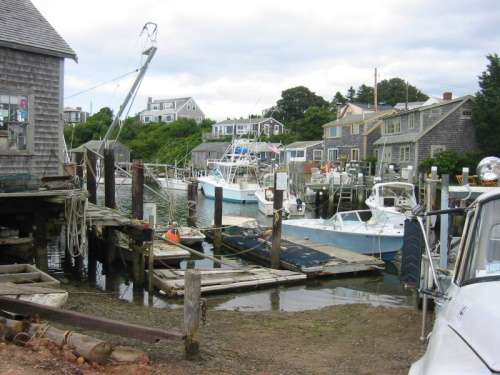
Menemsha Harbor in Chilmark. Cagney was also an avid sailor.
Farmer Cagney
“In 1936 I attained one of my best and fondest dreams – I bought a farm,” he wrote. “Martha’s Vineyard then was uncluttered with developers (which is too gracious a designation for those gentlemen; developers actually develop nothing but their own bankrolls). I couldn’t think of anything more satisfactory, more life-fulfilling, than living on a farm surrounded by salt water. This is what Martha’s Vineyard allowed me to do. The old, old house we found there – its building deed reads 1728—met my expectations wonderfully, and everything about the land and its situation charmed me right out of my shoes.”
Moreover, he wrote, property taxes amounted to $39 a year. He figured he could always scrape up $39.
“I used to lie in my California bed and dream of that old house in its very happy state of quiet decay,” he wrote. “I loved it beyond words, and at the time I said to myself, “If I had just six months to live, I’d spend them at the Vineyard”.”
Summer people had been coming to the Vineyard for decades, and Cagney found like-minded friends on the island. An amateur artist, he painted and drew with two other summer sojourners, artists Thomas Hart Benton and Sanford Ballard Dole Low. At night they’d sit around smoking cigarettes, drinking liquor and sketching each other.
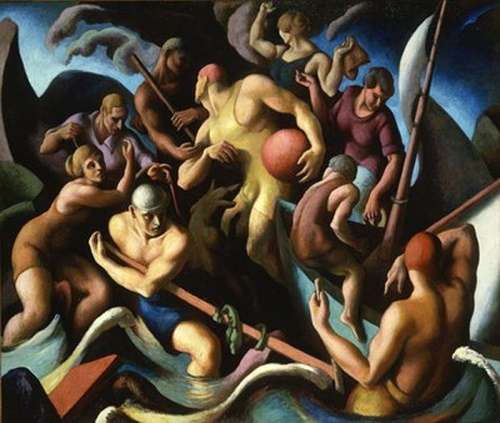
People of Chilmark by Thomas Hart Benton.
Parenthood, Sort of
At home in Chilmark, Billie doted on her increasingly famous husband. She made sure he always had a hot meal and enforced his privacy. No one could make noise while he concentrated on studying his lines. Over the next 20 years, he would make 30 films and become one of the leading Hollywood film stars. He would earn nominations for three Academy Awards and win an Oscar for his performance in Yankee Doodle Dandy.
In 1941, they adopted two children a year apart: a boy they named James Francis Cagney, Jr., and a girl they named Catherine, called Casey. “He was a perfectly beautiful little guy,” wrote James Cagney. “Casey, also beautiful, equally important to us right from the beginning.”
Cagney recalled the “wonderful, wonderful feeling of having them both sit on my lap as I told them stories.”
People who knew him on Martha’s Vineyard said he tried to spend time with the kids, at least in the early years. His demanding career didn’t allow him to see much of them, though.
Billie was much tougher on the children., friends later said. Very early in their young lives, she decided to build a separate house for them at their home in Coldwater Canyon. She also relegated them to the two-story guesthouse on Martha’s Vineyard, 200 feet away from the main house. They weren’t allowed to play in their parents’ house or to bring friends to it. A Japanese couple took care of the children.
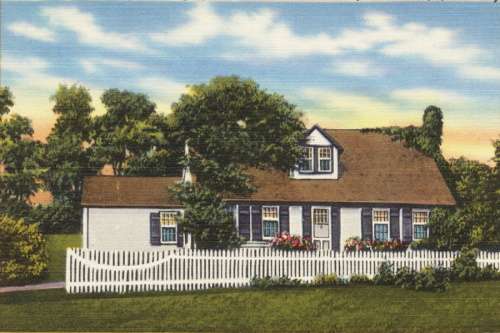
James Cagney’s house in Chllmark. The children lived in a separate house 200 feet away.
“That living in another house — I can’t think Jim Junior and Casey could do anything other than resent it,” said an old family friend.
Estrangement, and Sad Endings
Cagney’s efforts at farming his Chilmark estate didn’t work out too well. He found the soil poor, and he couldn’t get help. So in 1955, when the children reached their teens, he bought a farm in Dutchess County, New York, and called it Verney Farm. There he raised cattle and Morgan horses.
His friends on Martha’s Vineyard began to age and die, and he and Billie found Verney Farm more accessible. He spent less and less time on the Vineyard, and finally gave the farm to Jim Jr. Jim Jr. couldn’t keep up the farm and sold it.
The children grew estranged from their parents. Jim Jr., joined the Marines. His father sent him checks, which he refused to cash. He wanted his father’s attention, not his money. They grew further apart. Jim Jr., left the Marines, married, had two children and ran a gas station in South Portland, Maine. Once he went to his parents’ farm to reconcile with them. Police escorted him off the property. He died of a heart attack at 42, two years before his father’s death.
Casey loved horses as her father did. She married Jack Thomas, who worked on her father’s farm. They had two daughters and divorced. Plagued by health problems, she died of cancer at the age of 64. She, too, grew estranged from her parents and didn’t speak to them in the years before they died.
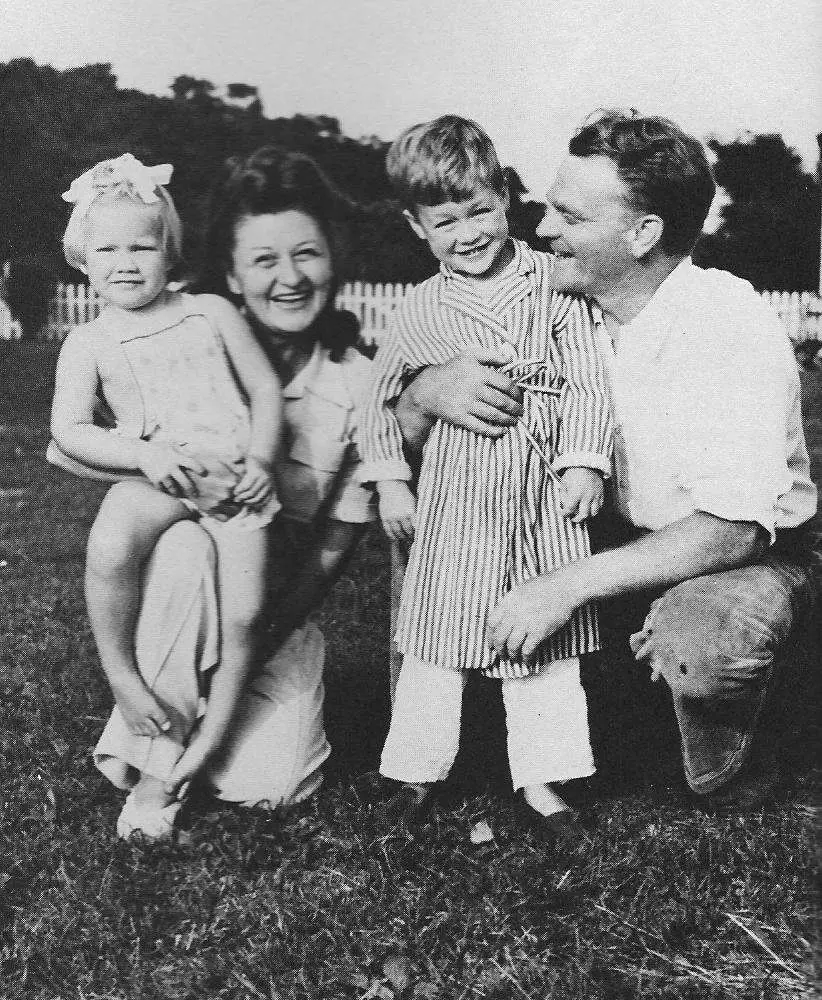
Casey, Billie, Jim Jr., James Cagney
Death
James Cagney died at Verney Farm on March 30, 1986. He left his personal belongings to Billie and nothing to his children. He had written the will in 1982, two years before Jim died.
Cagney added Article VI to his will:
I have intentionally made no provision for any grandchild of mine because I believe it is the obligation of each parent adequately provide for his own children during the parents’ lifetime just as I have done, and just as I believe my children should do for their children.
Martha’s Vineyard
In 2017, the house that once belonged to James Cagney went on the market with an asking price of $13.5 million. The description of the property noted it had 69 acres, the house where the late actor lived and a “guesthouse.” It left out the sad fact the guesthouse, 200 feet away, had been home for his two small children.
Images: James Cagney summer residence on Chilmark by Boston Public Library via Flickr CC By 2.0.; Menemsha Harbor By User:Elkman – http://en.wikipedia.org/wiki/Image:Menemsha.jpg, CC BY-SA 3.0, https://commons.wikimedia.org/w/index.php?curid=1350749. Grapefruit scene by Dennis Amith via Flickr, CC By-SA 2.0. Billie Cagney, Fair Use. Family photo, Fair Use. This story updated in 2023.
